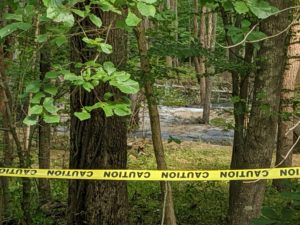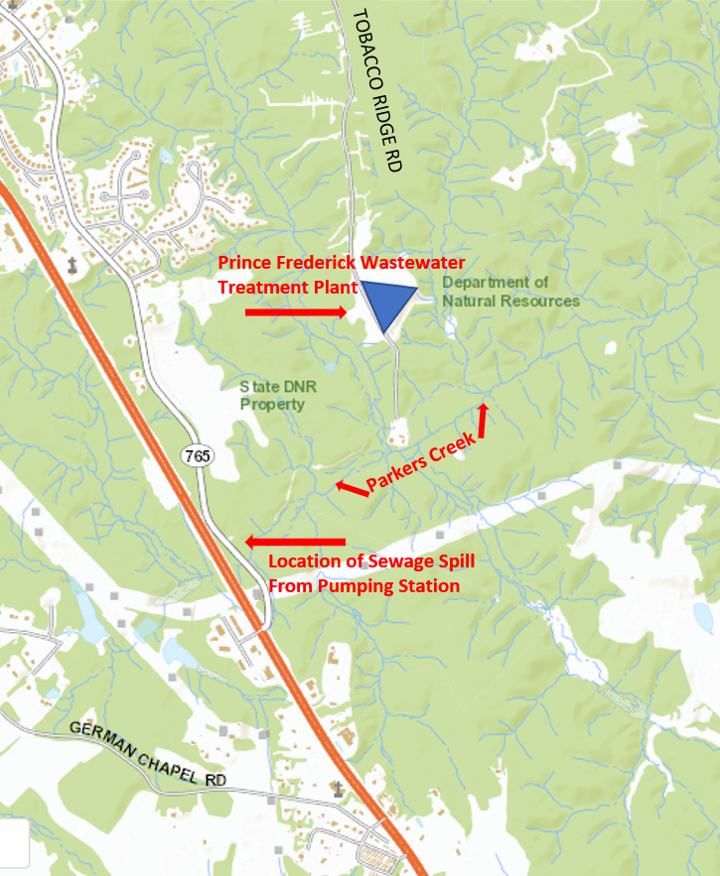
On August 5, 2020, the County issued a press release noting that “On the afternoon of Tuesday, Aug. 4, 2020, due to the excessive rainfall brought about by Tropical Storm Isaias, erosion beneath the Main Street roadway in Prince Frederick damaged a sewer line and caused a sewage force main to rupture. As a result, sewage was discharged 200 yards north of the headwaters of Parkers Creek.”
It noted that “A substantial quantity of effluent was controlled through shutting down pump stations and removal with pump trucks.” In a conversation with a senior county official, we learned that 10s of thousands of gallons were discharged into the creek before the pumping station was shut down. We are grateful that county staff moved quickly to shut it down.
To some extent, this re-opens a concern that ACLT has had about the Prince Frederick sewage treatment facility off of Tobacco Ridge Road, south of Dares Beach Road, which is the site of the original Prince Frederick Wastewater Treatment Plant. It was built in 1973 and was a small plant that discharged treated effluent directly into Parkers Creek.

However, the County Water and Sewer Plan was revised to prohibit future water systems from having direct discharge into waterways. In other words, new systems had to use land application. By doing so, Calvert County was leading the way in the state in addressing the impact of sewage treatment plants on the Chesapeake Bay.
A new Prince Frederick treatment plant opened in 1991 off of Barstow Rd, a much larger plant with a rated capacity of 450,000 gallons, and the Tobacco Ridge Road plant was decommissioned. The treated effluent from the Barstow Plant is applied to approximately 100 acres of forests and fields, according to the 2014 Water and Sewer Plan.
Since then, the Prince Frederick town center has continued to grow, creating a need for more sewage capacity. In 2002, the County submitted plans to the public for a new 300,000 gallon land application treatment facility at the site of the original Plant on Tobacco Ridge Road. ACLT raised its opposition for the facility, noting that Parkers Creek is a “pristine” watershed, and expressing concerns that the system would fail and pollute the Creek. The County approved the plan despite ACLT’s concerns, but it promised to give ACLT the results of its monitoring of the Creek and the groundwater surrounding the Plant, which it has done. Meanwhile, ACLT continued its own stream monitoring, measuring nitrogen and phosphorus levels in the water below the Plant. Thus far, we have not detected a significant increase in either nitrogen or phosphorus since the Plant was completed.
The facility has an 18 million-gallon storage/holding pond and an additional 3.8-million-gallon emergency storage space. To date, the storage facilities have handled the facility usage and the storms.
The August 4th event was not a failure of the Plant. It was due to storm damage of the pump station that pumps sewage to the Plant, allegedly caused by the partial collapse of the road during heavy rains from Tropical Storm Isaias.
What are the lessons to be learned from Tropical Storm Isaias?
First, meteorologists have been saying for some time that we should expect storms to become more severe and to produce more rainfall. As a result, infrastructure like pumping stations and stormwater management devices which were designed for lesser storms need to be better fortified. Related to that is the need to re-evaluate the Plant itself to see if it will be able to handle future storms and the substantial growth of the Prince Frederick Town Center currently proposed. Isaias was only a tropical storm. However, it moved so slowly that it wound up dumping approximately 10 inches of rain in just 14 hours. Houston Texas has been devasted twice in the last few years from slow moving storms. Hurricane Harvey dumped an unheard of 51” of rain in the Houston area. What would happen to Prince Frederick’s 18-million-gallon storage/holding pond if a hurricane dumped 20” of rain on Prince Frederick as did a storm a few years ago in lower Charles County? The resulting sewage and sediment from the dams could permanently alter our watershed.
Finally, land application of sewage is still an experimental system that has been used in but a few places in Maryland and the U.S. We are concerned that the ground may eventually be saturated by the accumulation of phosphorus in the soil and that could cause damage not yet understood. If that turns out to be the case, Calvert needs a “Plan B”.
Resilience is a term that is becoming more prevalent as we all are beginning to see more signs of climate change. An ounce of prevention is worth a pound of cure. We will be urging the County to use resilience planning and design to ensure that sewage systems and stormwater management are adequately addressed during the Prince Frederick Master Plan update, which is currently underway.